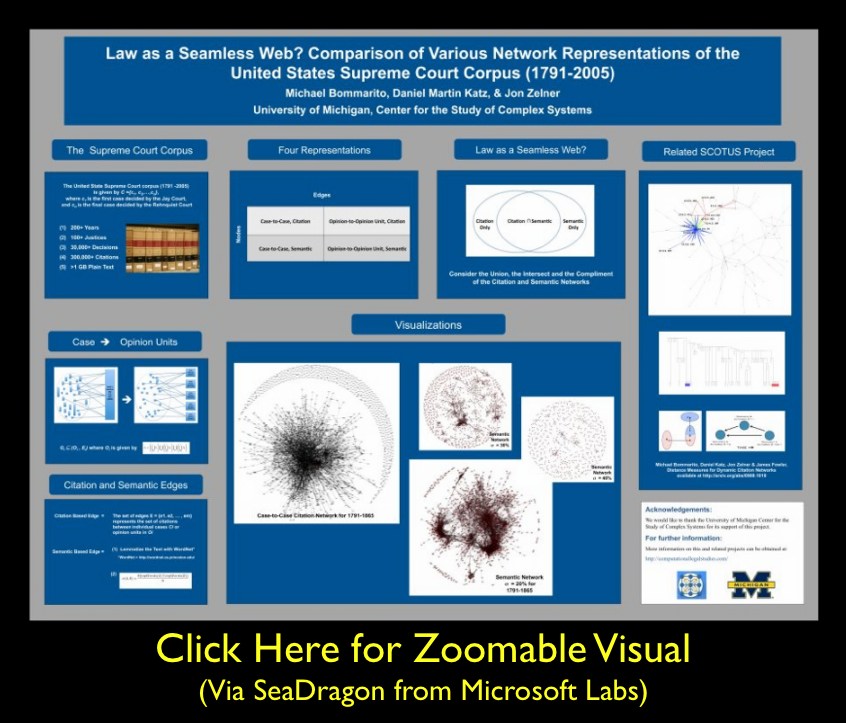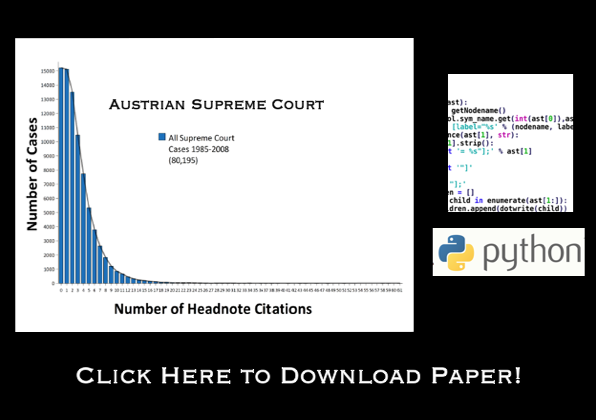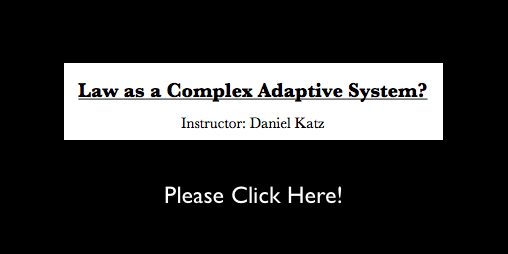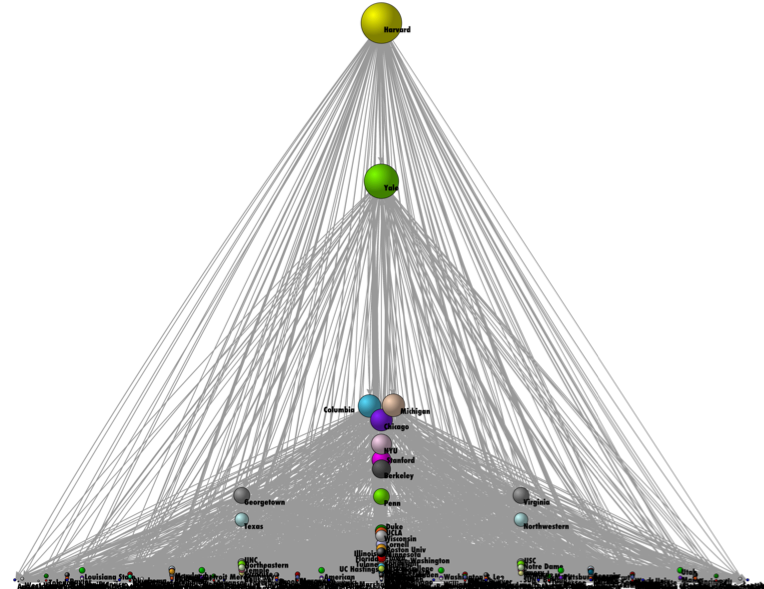As we mentioned in previous posts, Seadragon is a really cool product. Please note load times may vary depending upon your specific machine configuration as well as the strength of your internet connection. For those not familiar with how to operate it please see below. In our view, the Full Screen is best the way to go ….
Tag: Law as a Complex System
Positive Legal Theory and a Model of Intellectual Diffusion on the American Legal Academy [Repost from 4/22]
 For the third installment of posts related to Reproduction of Hierarchy? A Social Network Analysis of the American Law Professoriate, we offer a Netlogo simulation of intellectual diffusion on the network we previously visualized. As noted in prior posts, we are interested legal socialization and its role in considering the spread of particular intellectual or doctrinal paradigms. This model captures a discrete run of the social epidemiological model we offer in the paper. As we noted within the paper, this represents a first cut on the question—where we favor parsimony over complexity. In reality, there obviously exist far more dynamics than we engage herein. The purpose of this exercise is simply to begin to engage the question. In our estimation, a positive theory of law should engage the sociology of the academy — a group who collectively socialize nearly every lawyer and judge in the United States. In the paper and in the model documentation, we offer some possible model extensions which could be considered in future scholarship.
For the third installment of posts related to Reproduction of Hierarchy? A Social Network Analysis of the American Law Professoriate, we offer a Netlogo simulation of intellectual diffusion on the network we previously visualized. As noted in prior posts, we are interested legal socialization and its role in considering the spread of particular intellectual or doctrinal paradigms. This model captures a discrete run of the social epidemiological model we offer in the paper. As we noted within the paper, this represents a first cut on the question—where we favor parsimony over complexity. In reality, there obviously exist far more dynamics than we engage herein. The purpose of this exercise is simply to begin to engage the question. In our estimation, a positive theory of law should engage the sociology of the academy — a group who collectively socialize nearly every lawyer and judge in the United States. In the paper and in the model documentation, we offer some possible model extensions which could be considered in future scholarship.
Once you click through to the model, here is how it works:
(1) Click the Setup Button in the Upper Left Corner. This will Display the Network in the Circular Layout.
(2) Click the Layout Button. Depending upon the speed of your machine this may take up to 30 seconds. Stop the Layout Button by Re-Clicking the Button.
(3) Click the Size Nodes by Degree Button. You Will Notice the Fairly Central Node Colored in Red. This is School #12 Northwestern University Law School. Observe how we have set the default infected school as #12 Northwestern (Hat Tip to Uri Wilensky). A Full List of School Number is available at the bottom of the page when you click through.
(4) Now, we are ready to begin. Click the Spread Once Button. The idea then reaches its neighbors with probability p (set as a default at .05). You can click the Toggle Infection Tree button (at any point) to observe the discrete paths traversed by the idea.
(5) Click the Spread Once Button, again and again. Notice the plot tracking the time on the x axisand the number of institution infected on the y axis. This is an estimate of the diffusion curve for the institution.
(6) To restart the simulation, click the Reinfect One button. Prior to hitting this button, slide theInfected Slider to any Law School you would like to observe. Also, feel free to adjust the p slider to increase or decrease the infectiousness of the idea.
Please comment if you have any difficulty or questions. Note you must have Java 1.4.1 + installed on your computer. The Information Technology professionals at many institutions will have already installed this on your machine but if not you will need to download it. We hope you enjoy!
Power Laws, Preferential Attachment and Positive Legal Theory [Part 2] [Repost]
As was stated in Part 1 of this thread, it is by no means a given that the statistical artifact displayed above would appear. Namely, such large scale patterns need not assume this flavor as many social and physical systems feature substantially different properties.
For purpose of generating an empirically grounded theory of American Common Law development … explaining these artifacts would seem to critical. Fortunately, with respect to the above pattern, there exist a definable set of generative processes plausibly responsible for producing what is displayed. While certainly not the only generative process responsible for a power law, the preferential attachment model, first outlined in the physics literature by Barabási & Albert, is among the likely candidates.
Confronting much of the extant literature, query as to whether a closed form equilibria based analytical apparatus (punctuated or otherwise) is up to the task of describing the relevant dynamics? If anything, the distributions displayed above provide first-order evidence of a system which is likely to feature dynamics of a non-linear flavor. Indeed, while significant work still remains, the weight of available evidence indicates Law is a Complex Adaptive System. As such, we believe it would be appropriate to leverage the methods typically reserved for the study of complexity. For purposes of generating positive legal theory, we believe agent based models, dynamic network analysis and other methods of computational social science offer great potential. We encourage scholars to consider learning more about these approaches.
Citation Analysis in Continental Jurisdictions
Anton Geist has posted Using Citation Analysis Techniques for Computer-Assisted Legal Research in Continental Jurisdictions to the SSRN. While this is certainly longer than most papers, we believe it offers a good review of the broader information retrieval and law literature. In addition, it offers some empirical insight into citation patterns within continental jurisdictions. The findings in this paper are similar to those shown in important papers by Thomas Smith in The Web of the Law and by David Post & Michael Eisen in How Long is the Coastline of Law? Thoughts on the Fractal Nature of Legal Systems.
In our view, the next step for this research is to determine whether the pattern does indeed follow a power law distribution. Specifically, there exists a Maximum Likelihood based test developed in the applied physics paper Power-law Distributions in Empirical Data by Aaron Clauset, Cosma Shalizi and Mark Newman which can help adjudicate whether the detected pattern represents a highly skewed distribution or is indeed a power law.
Either way, we are excited by this paper as we believe comparative research is absolutely critical to broader theory development.
Law as a Seamless Web? Part II
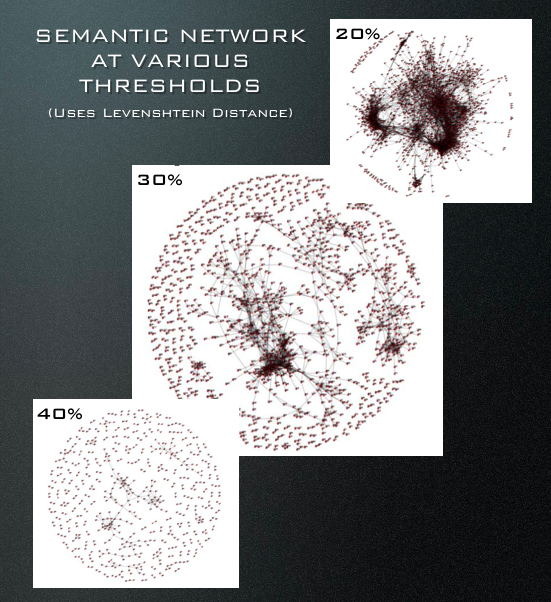
In our paper Law as a Seamless Web, we offer a first-order method to generate case-to-case and opinionunit-to-opinionunit semantic networks. As constructed in the figure above, nodes represent cases decided between 1791-1865 while edges are drawn when two cases possess a certain threshold of semantic similarity. Except for the definition of edges, the process of constructing the semantic graph is identical to that of the citation graph we offered in the prior post. While computer science/computational linguistics offers a variety of possible semantic similarity measures, we choose to employ a commonly used measure. Here a description from the paper:
“Semantic similarity measures are the focus of significant work in computational linguistics. Given the scope of the dataset, we have chosen a first-order method for calculating similarity. After lemmatizing the text of the case with WordNet, we store the nouns with the top N frequencies for each case or opinion unit. We define the similarity between two cases or opinion units A and B as the percentage of words that are shared between the top words of A and top words of B.
 An edge exists between A and B in the set of edges if σ (A,B) exceeds some threshold. This threshold is the minimum similarity necessary for the graph to represent the presence of a semantic connection.”
An edge exists between A and B in the set of edges if σ (A,B) exceeds some threshold. This threshold is the minimum similarity necessary for the graph to represent the presence of a semantic connection.”
As this a technical paper, it is slanted toward demonstrating proof of methodological concept rather than covering significant substantive ground. With that said, we do offer a hint of our broader substantive goal of detecting the spread of legal concepts between various topical domains. Specifically, with respect to enriching positive political theory, we believe union, intersect and compliment of the semantic and citation networks are really important. More on this point is forthcoming in a subsequent post…
Reading List — Law as a Complex System [Repost from May 15th]
Several months ago, I put together this syllabus for use in a future seminar course Law as a Complex System. This contains far more content than would be practical for the typical 2 credit seminar. However, I have decided to repost this because it could also serve as a reading list for anyone who is interested in learning more about the methodological tradition from which must of our scholarship is drawn. If you see any law related scholarship you believe should be included please feel free to email me.
Law as a Seamless Web?
We have recently posted Law as a Seamless Web? Comparison of Various Network Representations of the United States Supreme Court Corpus (1791-2005) to the SSRN. Given this is the first of several posts about the paper, I will speak broadly and leave details for a subsequent post. From the abstract “As research of judicial citation and semantic networks transitions from a strict focus on the structural characteristics of these networks to the evolutionary dynamics behind their growth, it becomes even more important to develop theoretically coherent and empirically grounded ideas about the nature of edges and nodes. In this paper, we move in this direction on several fronts …. Specifically, nodes represent whole cases or individual ‘opinion units’ within cases. Edges represent either citations or semantic connections.” The table below outlines several possible network representations for the USSC corpus.
The goal of the paper is to do some technical and conceptual work. It is a small slice of broader project with James Fowler (UCSD) and James Spriggs (WashU). We recently presented findings from the primary project at the Networks in Political Science Conference. The main project is entitled The Development of Community Structure in the Supreme Court’s Network of Citations and we hope to have a version of this paper on the SSRN soon. In the meantime, we plan additional discussion of Law as a Seamless Web in the days to come.
Marginal Returns and the Mechanics of a Computational Legal Study
As noted earlier, we imposed a break over the Memorial Day Weekend and hope to return to a regular posting schedule this week. For the first post of the week, we want to reach out to readers exclusively socialized in legal or traditional social scientific circles. Namely, we recognize that a number of the approaches highlighted herein are not currently within the mainstream. Thus, many may not be familiar with the methods presented on this blog. So, just to reset ….
On this blog, we discuss scholarship or projects applying a computational, complex systems or informatics approach to questions of potential interest to legal and/or social science scholars. Our approach is unappolgetically interdisciplinary as we attempt to weave together a wide range of scientific methods and intellectual traditions. We have or will feature relevant scholarship from computer science, physics, network science, empirical legal studies, information visualization, new social history, computational politics and economics, mathematical sociology, behavioral biology, neuroscience, anthropology, linguistics ….
We have deeper motivations — but at a minimum — we believe the embrace of the techniques presented herein is justified as a search for intellectual returns on investment. While not applicable to all substantive questions, where appropriate we believe our approach to scholarship can convert higher-hanging fruit into low-hanging fruit.
It is hardly a revelation to note that disciplines tend to be insular. They develop cultures of intellectual reenforcement that can operate to stymie innovation by punishing deviations from status quo practices. Recognizing that switching costs are non-trivial, we want to once again highlight two articles previously discussed on this blog. For those interested in exploring a different terrain, we believe these articles offer both the rationale for and some of the mechanics of a computational approach to legal studies.
The first article, drawn from a recent issue of Science Magazine and authored by some of the leaders in field, highlights some of the possibilities of and potential perils associated with a computational revolution in the social sciences. It is a call to arms to many in social science circles. In a similar vein, Paul Ohm’s forthcoming article represents the law review analog. Among other things, Professsor Ohm offers a concrete playbook for those interested in applying the relevant mechanics to some discrete question of interest. The code displayed above is drawn from his article.
Syllabus–Modeling Law as a Complex Adaptive System
Several months ago, I put together this syllabus for use in a future seminar course Law as a Complex System. A number of my friends and colleagues noted that if were to actually use this syllabus in a course, it would be necessary to reduce the total reading in contained herein. While I completely agree, I still thought I would post it to the blog in its current form. I am proud to say that I am an award winning instructor. Notwithstanding, I am always interested in improving my pedagogical skills. Thus, if you see any law related scholarship you believe should be included please feel free to email me.
Model of Intellectual Diffusion Upon the American Legal Academy
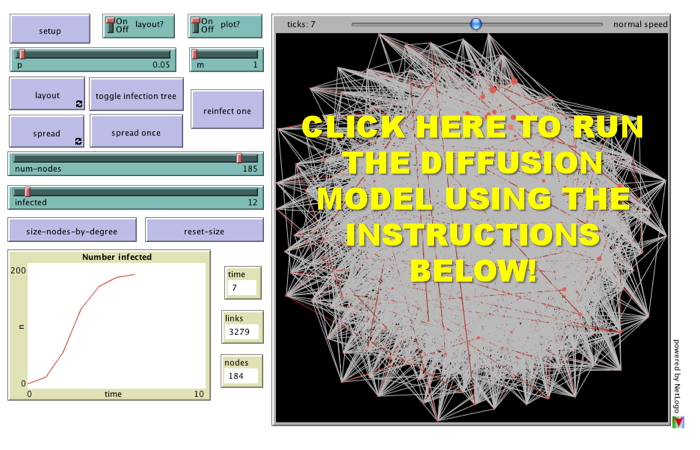 For the third installment of posts related to Reproduction of Hierarchy? A Social Network Analysis of the American Law Professoriate, we offer a Netlogo simulation of intellectual diffusion on the network we previously visualized. As noted in prior posts, we are interested legal socialization and its role in considering the spread of particular intellectual or doctrinal paradigms. This model captures a discrete run of the social epidemiological model we offer in the paper. As we noted within the paper, this represents a first cut on the question—where we favor parsimony over complexity. In the paper and in the model documentation, we offer some possible model extensions which could be considered in future scholarship.
For the third installment of posts related to Reproduction of Hierarchy? A Social Network Analysis of the American Law Professoriate, we offer a Netlogo simulation of intellectual diffusion on the network we previously visualized. As noted in prior posts, we are interested legal socialization and its role in considering the spread of particular intellectual or doctrinal paradigms. This model captures a discrete run of the social epidemiological model we offer in the paper. As we noted within the paper, this represents a first cut on the question—where we favor parsimony over complexity. In the paper and in the model documentation, we offer some possible model extensions which could be considered in future scholarship.
Once you click through to the model, here is how it works:
(1) Click the Setup Button in the Upper Left Corner. This will Display the Network in the Circular Layout.
(2) Click the Layout Button. Depending upon the speed of your machine this may take up to 30 seconds. Stop the Layout Button by Re-Clicking the Button.
(3) Click the Size Nodes by Degree Button. You Will Notice the Fairly Central Node Colored in Red. This is School #12 Northwestern University Law School. Observe how we have set the default infected school as #12 Northwestern (Hat Tip to Uri Wilensky). A Full List of School Number is available at the bottom of the page when you click through.
(4) Now, we are ready to begin. Click the Spread Once Button. The idea then reaches its neighbors with probability p (set as a default at .05). You can click the Toggle Infection Tree button (at any point) to observe the discrete paths traversed by the idea.
(5) Click the Spread Once Button, again and again. Notice the plot tracking the time on the x axis and the number of institution infected on the y axis. This is an estimate of the diffusion curve for the institution.
(6) To restart the simulation, click the Reinfect One button. Prior to hitting this button, slide the Infected Slider to any Law School you would like to observe. Also, feel free to adjust the p slider to increase or decrease the infectiousness of the idea.
Please comment if you have any difficulty or questions. Note you must have Java 1.4.1 + installed on your computer. The Information Technology professionals at many institutions will have already installed this on your machine but if not you will need to download it. We hope you enjoy!
A Social Network Analysis of the American Law Professoriate (Part II)
This is the second post related to our recently released paper Reproduction of Hierarchy? A Social Network Analysis of the American Law Professoriate. We believe a hierarchical depiction of the network helps uncover latent distribution of authority present in the law professor network. Specifically, between 10-15 law schools are responsible socializing a significant percentage of the future legal academics.
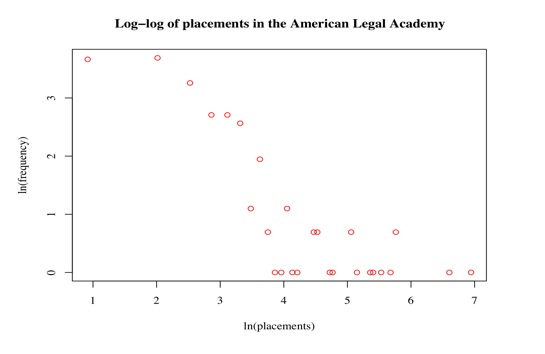
This extreme skewing of social authority presented in the visualization is also displayed in the above log-log of the degree distribution. While the -1.93 alpha level and size of the network falls outside the traditional power law/scale free range, the plot above does demonstrate the extreme skewing of social authority among institutions of legal education.
This is the time of year when there is significant discussion of the US News Rankings. We believe there is a wide-class of available data—data which could be characterized as the revealed preferences of important actors within the American legal system. For example, we have previous offered information on how judges select clerks from law schools? Now, we offer some empirical insight into how hiring committees vote over various institutions?
Coming later in the week, we will offer a Netlogo GUI which allows a user to start ideas at various institutions and observe how many generations they take to spread from institution to institution. There are significant caveats in the interpretation of our model but we think many people will still find it interesting. Please stay tuned and as always please tell your friends and colleagues about the CLS Blog!
A Social Network Analysis of the American Law Professoriate (Part I)

Last month, my colleagues and I posted Reproduction of Hierarchy? A Social Network Analysis of the American Law Professoriate to the SSRN. We have been quite happy with the initial response to the article. It has been posted on a number of blogs including ELS Blog, Tax Prof Blog, Legal Theory Blog, US News and World Report Blog as well as several others.
To develop the network, our paper uses an approach first developed in the network science literature by Fowler, Grofman & Masuoka. The network visualized above relies upon mapping the institution where an individual received their primary legal socialization to the institution where that individual acts to socialize the next generation. The example below demonstrates the move from our data set to the full graph of 184 Institutions and 7,200+ Professors. In the full graph, the institutions are sized by the number of inbound connections. Harvard Law School has the largest number of placements and is the largest node contained in the graph.

This is first of a multipart series of posts regarding the ideas contained in the paper. In subsequent posts, I hope to comment on a variety of matters including how we use the above network to computationally model spread of intellectual and doctrinal paradigms. To preview, we use the above network architecture in a Reed-Frost style social epidemiological model.
SEAL 2009 @ Vanderbilt Law School
I am currently at Vanderbilt Law School for the 2009 Society for Evolutionary Analysis in Law (SEAL) Conference. For those of you not familiar with the organization … “SEAL is a scholarly association dedicated to fostering interdisciplinary exploration of issues at the intersection of law, biology, and evolutionary theory, improving the models of human behavior relevant to law, and promoting the integration of life science and social science perspectives on law-relevant topics through scholarship, teaching, and empirical research.” The organization embraces a wide range of scholarship including those with interests in evolutionary and behavioral biology, complex adaptive systems, economics, psychology, primatology and anthropology.
In the coming days, we will be highlighting our work on The American Legal Academy and previewing extensions of the paper Reproduction of Hierarchy? A Social Network Analysis of the American Law Professoriate. So stay tuned for this and more… please add us to your blogrolls and tell your colleagues about the CLS Blog.
Hustle & Flow: A Network Analysis of the American Federal Judiciary

This paper written by CLS Blog Co-Founder Daniel Katz and Derek Stafford from the University of Michigan Department of Political Science representes an initial foray into Computational Legal Studies by the graduate students here at the University of Michigan Center for the Study of Complex Systems. The full paper contains a number of interesting visualizations where we draw various federal judges together on the basis of their shared law clerks (1995-2004). The screen print above is a zoom very center of the center of the network. Yellow Nodes represent Supreme Court Justices, Green Nodes represent Circuit Court Justices, Blue Nodes represent Circuit Court Justices. Here is a wide shot of the broader network visualized using the Kamada-Kawai visualization algorithm:
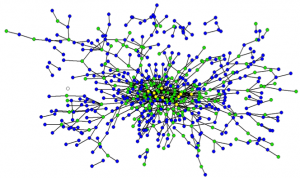
Here is the abstract: Scholars have long asserted that social structure is an important feature of a variety of societal institutions. As part of a larger effort to develop a fully integrated model of judicial decision making, we argue that social structure-operationalized as the professional and social connections between judicial actors-partially directs outcomes in the hierarchical federal judiciary. Since different social structures impose dissimilar consequences upon outputs, the precursor to evaluating the doctrinal consequences that a given social structure imposes is a descriptive effort to characterize its properties. Given the difficulty associated with obtaining appropriate data for federal judges, it is necessary to rely upon a proxy measure to paint a picture of the social landscape. In the aggregate, we believe the flow of law clerks reflects a reasonable proxy for social and professional linkages between jurists. Having collected available information for all federal judicial law clerks employed by an Article III judge during the “natural” Rehnquist Court (1995-2004), we use these roughly 19,000 clerk events to craft a series of network based visualizations. Using network analysis, our visualizations and subsequent analytics provide insight into the path of peer effects in the federal judiciary. For example, we find the distribution of “degrees” is highly skewed implying the social structure is dictated by a small number of socially prominent actors. Using a variety of centrality measures, we identify these socially prominent jurists. Next, we draw from the extant complexity literature and offer a possible generative process responsible for producing such inequality in social authority. While the complete adjudication of a generative process is beyond the scope of this article, our results contribute to a growing literature documenting the highly-skewed distribution of authority across the common law and its constitutive institutions.

